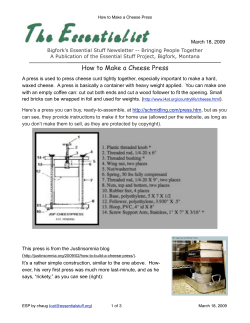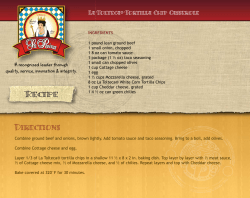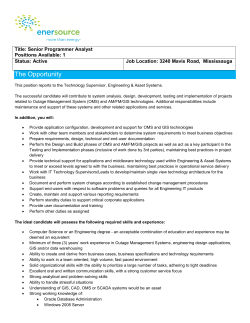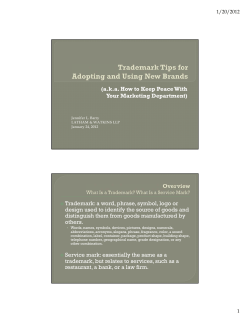
The P.G.I.
The P.G.I. • What is a GI? • Why making a PGI? • Agen guidelines • Agen P.G.I. P G I toda today • Some comments GI: ideal tool to bring local savoir faire into the market What is a Geographical Indication? What is a GI? TRIPS Agreement, part of the 1994 GATT/WTO Uruguay Round of Negotiations “Trade-Related aspects of Intellectual Property rights” A legal tool to protect names of goods when they represent Article 22 Protection of Geographical Indications 1. Geographical indications are, for the purposes of this Agreement, Specific • Qualities • Reputation • Other characteristics indications which identify a good as originating in the territory of a geographical Member, or a region or locality in that territory, where a given quality, origin reputation or other characteristic of the good is essentially attributable to its geographical origin. © Examples of GIs Food products Other traditional products Roquefort (France), Tequila (Mexico), Argan oil (Morocco), Café de Veracruz (Mexico), Café de Colombia (Columbia), Parma ham (Italy), Parmigiano Reggiano cheese (Italy), Agen prunes (France), Basmati rice, Darjeeling tea (India), Long-Jing tea (China), Antigua coffee (Guatemala), Kona coffee (HW, USA), Champagne (France), Napa Valley wines (CA, USA), etc. Kilim carpets (Turkey), Thai silk (Thailand), Murano cristal (Italy) etc. Quality and characteristics linked to geographical origin Argan Oil tree, tree, Morocco Antigua Coffee area, Guatemala © © 1 Socio‐‐economic rationale behind GIs Socio Common elements Producers Market geographical origin through differentiation Turn commodities into “niche products” “Capture” value added and increase revenues Consumers More conscious and demanding (quality, health, methods of production, environmental concerns) Ready to pay a premium price (GIs increase market transparency and reduce transaction costs) GI Markets Trade regulations have been shifting towards traceability © GIs bring added value to producers GIs bring added value to consumers GIs guarantee production methods, methods, authenticity Antigua Coffee (Guatemala) and quality to consumers Average world price of coffee grains: 0.50 $/lb Average world price of Antigua coffee grains: 1.5 $/lb Year 2002 • Study of European Consumers by the EC in 1999: Cheese and Wine and Prunes from France Cheese retail price €/kg P.G.I. cheeses Wine price €/liter (1) P.G.I. wines Prunes price Imports into Europe €/kg (2) (3) +230 % 43% ready to pay an extra 10% for GI products 8% ready to pay up to an extra 20% for GI products Agen P.G.I. +30 % +46 % All cheeses Other origins 4,19 10,42 3% ready to pay up to an extra 30% for GI products 2,90 Other wines 8,11 © 1,99 1,28 (1) Based on retail benchmark SECODIP, 2002 (2) Based on exports 1999-2001 (3) Based on imports 2008-2010 Source : MAAPAR, FranceAgriMer, UbiFrance, INAO, BIP © Comparison between GI and trademark Trademark ≠ © Comparison between GI and trademark Geographical indication Trademark Area of production not relevant Production rooted in a region Emphasis on the company owning them Emphasis on the origin of the product Protection only available to the company that owns the brand Protection available to all producers of the area who meet the guidelines © ≠ Geographical indication Exclusive Right bought by first petitioner Exclusivity granted by Gov’t Gov t upon evidence of longlong-time reputation and specificity and traceability Limited--inLimited in-time validity with renewal fee Permanent right – no renewal fee © 2 Examples of GI misuses around the world Better protection of Gis needed! Increasing abuses of GI products • Undermine Unde mine the reputation ep tation of famous famo s local products p od cts • Result on devastating effects for producers • Mislead the consumers as to the identity of the goods • Chase away demanding consumers • Cases of abuses exist all around the globe • • • • • • • • IN Kasmati, Jasmati Rice IT Parmesan cheese IT Parma Ham ES Turrón de Alicante ES Manchego cheese FR Roquefort cheese MX Tequila etc. USA USA Canada Mexico Argentina New Zealand Israel © © www.origin-gi.com • OriGIn ORganization for an International Geographical Indications Network – a NGO launched in June 2003 by producers from all over the world • Headquarters in Geneva (Switzerland) • President from Mexico, Vice-presidents from Africa (North, Sub-Saharian), Asia (China, India), America (North, Central, South), Europe (Western, Eastern) • An International organization of GI producers: – Over 350 organizations of producers from 40 countries © Why making a P.G.I. for Agen Prunes? About Agen Prunes • Why making a PGI? AGEN PRUNES DOMINATE THE FRENCH DOMESTIC MARKET • Misleadings 35 000 • Agen P.G.I. P G I toda today 30 000 • Some comments 25 000 Imported Prunes 20 000 Agen Prunes 15 000 10 000 5 000 2009 2007 2005 2003 2001 1999 1997 1995 1993 1991 1989 1987 1985 1983 1981 1979 1977 1975 1973 1971 1969 1967 1965 0 1963 • Agen guidelines tonnes 3 Why making a P.G.I.? Why making a P.G.I.? MAIN GROWTH IS WITHIN THE E.U. but with increasing interests in third countries IN FRANCE, AGEN PRUNES ENJOY ENVIABLE REPUTATION 70 000 tonnes • What does the town «Agen» remind you? 60 000 Answers: A - prunes - rugby - sun, warmth - the South 50 000 Export 40 000 30 000 French market 20 000 10 000 2010 2005 2000 1995 1990 1985 1980 1975 1970 1965 0 84 % 16 % 10 % 9% SOFRES POLL 1996 SAMPLE OF 1051 FRENCH Legal conflicts on the name Legal conflicts on the name from Argentina… Forged pack found in Algeria What we do against misleadings How the P.G.I. works In Europe P.G.I. Legal protection of PGI since 2002, promotion of PGI/PDO Out of Europe Lobbying with multilateral WTO negotiators (OriGIn) Protection initiatives in producing countries (Chile and Argentina) Defence and prevention within consuming countries: Certification mark in Algeria, enforced 2011 Legal protection by EU in bilateral agreements e.g. with China, Corea, Peru, Colombia… • • • • The guidelines include: Geographic area Variety « d’Ente » Guarantees of traceability Main identity requirements: – Annual pruning, minimum size and max defects – Ripeness, harvest in several passes – Compliance with specific standards • Control procedures 4 Quality Layout PGI/PDO legal keeper Validates Guidelines Mandates Certification Body Decides penalties INAO (Gov’t) Food Certification Body Independent and certified EN45011 Controls the methods and practices of Operators and Syndicat (external) Enforces penalties Guideline author and bookkeeper p Registers and supervises internal controls Keeps and communicates statistics Our P.G.I. today INDUSTRY MASSIVE SUPPORT TO THE APPROACH • 94% of French production within area • 1400+ 1400 producers, d i.e. i 98.8% 98 8% • 100% of the field-buying packers 7 Grower Organizations Ensure internal control with their 15 field technicians 1400 growers Commit with the Syndicat Comply with Guidelines Record their operations • 80% of the farm-door sellers (less than 0.5% of sales as a whole) 20 packers Our P.G.I. today Geographical Indication Specificities AN OUTPUT GUARANTEE • The PGI was registered in 2002 • It covers 94% of the French production, which is 97% of the European production. However an average of 60% of the production only is agreed to receive the denomination as meeting the quality requirements • The PGI does not directly increase prices but saves an image of difference • The French market absolutely requires the authentic denomination «Pruneau d’Agen» • Agen Prunes reputation is growing over other EU and non-EU markets as a high quality segment • Unlike a trademark, which belongs to a company, a G.I. is an inalienable public asset linked to a territory: a GI can neither be sold nor leave its territory (see Napa Valley case) • A Gov’t certified control body, which is independent to operators, guarantees that each operator fulfills the traditional production rules as registered in the Guidelines • Each operator can use his own trademark within a Geographical Indication • The producers have succeeded in linking the market with their terroir Examples associating Brand + GI G.I. stakes • Our World is more and more an open one. International trade is developing. Traditional quality values, which local quality products are part of, are threatened of being dissolved and killed by standard or low quality cheaper products • GI is a tool for maintaining a common asset which can be accessed by farmers, craftsmen and small businesses • GI does not impede free trade. It just clarifies the identity of differentiated products by preventing consumers of being confused • GI fits well with the modern need of quality differentiation 5 THANK YOU www.origin-gi.com Christian Amblard, May 2012 6
© Copyright 2025










